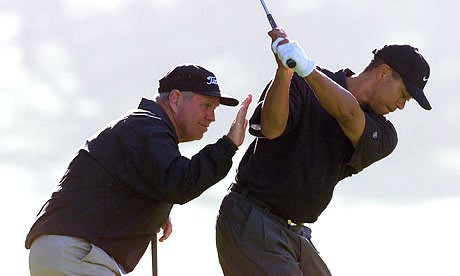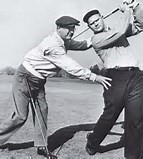How to Change Your Golf Swing – The Right Way

A Legacy Post by Keiser University College of Golf Senior Faculty and Director of Research Dr. T. J. Tomasi (1940-2023)
The poster boy for swing change is, of course, Tiger Woods, who changed the swing that won the 1997 Masters by 12 shots, one of four swing changes over his magnificent career – so far.

But here’s an important distinction– the changes were not knee-jerk reactions to a few bad shots. Champions plan their swing changes after a thoughtful, in-depth analysis of their game and their goals. So, if you’re going to change your swing like the pros do, rather than taking the knee-jerk route, follow these simple guidelines:
How to Change Your Golf Swing
- Develop a detailed blueprint for change, including a timeline and how you’ll know when you’re finished.
- Understand that you probably will get worse before you get better.
- Via a careful search, find yourself a teaching professional who can help you. Word of mouth is good but not sufficient. Pick up the phone and check out his or her resume carefully.
- Be committed to the changes and stick with your instructor for at least two years.
- Make sure there’s a personality fit between you and your coach.
- Special note: Listen to only one voice at a time. If you can’t do this, don’t change your swing!

Of course, many good players change their swings and become even better, as Jack Nicklaus did in 1979, but some change and get worse (e.g. Ian Baker-Finch), so it’s tough to know which category you’re in before you attempt the change. Below is the golfer’s profile that doesn’t do well making a swing change. If you answer yes to more than 40% of the questions, or if you answer yes to questions 1, 5, 6, or 9, you probably should stick with your current swing.
Recommended Drills and Exercises for Swing Improvement
Improving your golf swing requires consistency, muscle memory, and proper mechanics. Incorporating specific drills and exercises into your practice routine can help reinforce new swing patterns effectively.
- Mirror Drill – Stand in front of a mirror and perform slow, controlled swings while checking your posture, grip, and alignment. This visual feedback helps ingrain proper mechanics.
- Pause-and-Hold Drill—Swing to the top of your backswing, pause for a few seconds, and then complete the swing. This drill helps improve balance and control.
- Swing Path Alignment Drill – Place two alignment sticks on the ground, guiding your club’s path to encourage proper swing direction.
- Resistance Band Exercises – Strengthen core muscles and improve stability with rotational band exercises, which enhance swing power.
- One-Handed Swings – Practice swings using only your lead or trail hand to develop wrist control and arm strength.
Regularly practicing these drills can accelerate swing improvements and reinforce proper technique.
The Role of Professional Coaching in Swing Modification
Changing your golf swing can be challenging, but professional coaching can make the process more efficient and effective. Certified golf instructors offer customized, one-on-one guidance, helping golfers identify and correct swing mechanics that might go unnoticed when practicing alone.
One major advantage of working with a coach is video analysis. Coaches use high-speed and slow-motion cameras to break down a golfer’s swing in order to see adjustments. The visual feedback helps golfers see their mistakes to make it simpler to implement corrections.
Another benefit of personalized golf instructors is customized training plans. Every golfer has a unique physique and skill level, and a one-size-fits-all approach won’t work. A professional coach tailors drills and exercises to match an individual’s needs, ensuring gradual and sustainable improvement.
Coaches also help with the mental aspects of the game. Swing changes can be frustrating, but a coach provides motivation, structured progress tracking, and strategies to stay patient during the transition.
Professional golf coaching helps golfers improve via real-time feedback. Instead of repeatedly practicing incorrect techniques, a coach can instantly correct mistakes, preventing the formation of bad habits.
Choosing to hire or try professional golf coaching can assist in swing modifications that lead to long-term consistency, efficiency, and better performance.
If you want a more global view, have people who know you well answer the questions – make copies, and hand them out, but don’t ask for signatures since anonymity promotes a more unbiased/accurate response. Pick a friend to collect them when you’re not around, then analyze the responses against yours.
Questions For Changing Your Golf Swing
- Are you short-term, quick-fix-orientated?
- Is the ball your master, meaning that you make a swing adjustment after a bad shot to make the next shot a good one?
- Do you take swing advice from various sources regularly (e.g. golf channel, friends, and articles)?
- Do you have a low tolerance for failure?
- Is it hard to find the time to make major changes in your swing?
- Do you have a low tolerance for chaos, i.e., not being in control?
- Do you believe that since you work hard and put in the time, you “deserve” to play better?
- Does your golf performance affect your mood off the golf course?
- Is gambling (e.g., playing for money) important when you play golf?
- Do you dislike practicing?
- Do you quit when things aren’t going your way?
- Do you get angry and lose your temper when you play golf?
- Are you going to make the swing changes primarily on your own?
- Are you a poor re-learner (can’t teach the old dog new tricks)?
- Do you play a lot of stroke play amateur tournament golf?
You may be surprised that I included #9 as one of the biggest detriments to swing changes, but in my experience, having to hand over cash and/or costing your partner cash because you’re changing your swing creates too much social dissonance.
And while #15 would appear to be the same, it is not. If you’re a tournament player, it’s tough to make changes, but since you are playing against a large pool of players, their skills are a constant reminder to you that you have to update your skills. The gambler most often plays with the same group, and over time, a steady state is established, a balance that is painfully disturbed when one of the group changes performance levels.
Common Mistakes When Changing Your Golf Swing
Modifying your golf swing can be a game-changer, but many golfers make critical mistakes that hinder progress. Understanding your golf swing errors and how to improve can be crucial for a golfer.
- Improper Weight Transfer—One of the most common mistakes is failing to shift weight correctly during the swing. Many golfers either stay too centered or lean back, causing inconsistent ball striking. Solution: Focus on smoothly shifting your weight from the back foot to the front foot, ensuring proper balance throughout the swing.
- Poor Posture and Setup – A flawed stance can lead to inconsistent swings and reduced power. Slouching, improper knee flex, or incorrect ball positioning can all negatively affect performance. Solution: Maintain an athletic stance with a straight spine, slightly bent knees, and proper distance from the ball.
- Over-the-Top Swing Path – Many players struggle with an out-to-in swing path, which results in weak slices. Solution: Use drills that promote an inside-to-out swing, such as the alignment stick drill or slow-motion rehearsals.
- Rushing the Transition – Changing a swing takes time, but some golfers rush into it, leading to frustration. Solution: Focus on small, gradual adjustments and consistency over speed.
Avoiding these common mistakes can help golfers develop a more effective and repeatable swing. Watch a video from the College of Golf YouTube channel to learn more about common golf swing mistakes and flaws.
Improving Your Golf Swing: Uneven Lies
Watch the Keiser College of Golf YouTube series “Improving Your Golf Swing: Uneven Lies Part One – Downhill Slope” and “Improving Your Golf Swing: Uneven Lies Part Two – Uphill Lie”, covering downhill slopes and uphill lies.
Improving Your Golf Swing: Uneven Lies Part One – Downhill Slope
Improving Your Golf Swing: Uneven Lies Part Two – Uphill Lie
Learn expert techniques to master uneven terrain and improve your game.
Learn more!
Want more tips? If you want to take your game to the next level, contact our team at Keiser University’s College of Golf & Sport Management today. With our dedication and experience, we can elevate your game to new heights together. Give us a call today at 888-355-4465.














